Bisoxazoline ligand
Bis(oxazoline) ligands (often abbreviated BOX ligands) are a class of privileged chiral ligands containing two oxazoline rings. They are typically C2‑symmetric and exist in a wide variety of forms; with structures based around CH2 or pyridine linkers being particularly common (often generalised BOX and PyBOX respectively). The coordination complexes of bis(oxazoline) ligands are used in asymmetric catalysis. These ligands are examples of C2-symmetric ligands.

Synthesis
The synthesis of oxazoline rings is well established and in general proceeded via the cyclisation of a 2‑amino alcohol with any of a number of suitable functional groups. In the case of bis(oxazoline)s, synthesis is most conveniently achieved by using bi-functional starting materials; as this allows both rings to be produced at once. Of the materials suitable, dicarboxylic or dinitrile compounds are the most commonly available and hence the majority bis(oxazoline) ligands are produced from these materials.

Part of the success of the BOX and PyBOX motifs lies in their convenient one step synthesis from malononitrile and dipicolinic acid, which are commercially available at low expense. Chirality is introduced with the amino alcohols, as these are prepared from amino acids and hence are chiral (e.g. valinol).
Catalytic applications
In general, for methylene bridged BOX ligands the stereochemical outcome is consistent with a twisted square planar intermediate that was proposed based on related crystal structures.[1][2] The substituent at the oxazoline's 4-position blocks one enantiotopic face of the substrate, leading to enantioselectivity. This is demonstrated in the following aldol-type reaction,[3] but is applicable to a wide variety of reactions such as Mannich-type reactions,[4] ene reaction,[5] Michael addition,[6] Nazarov cyclization,[7] and hetero-Diels-Alder reaction.[8]
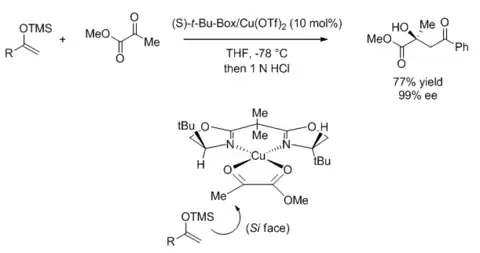
On the other hand, two-point binding on a Lewis acid bearing the meridially tridentate PyBOX ligand would result in a square pyramidal complex. A study using (benzyloxy)acetaldehyde as the electrophile showed that the stereochemical outcome is consistent with the carbonyl oxygen binding equatorially and the ether oxygen binding axially.[9]
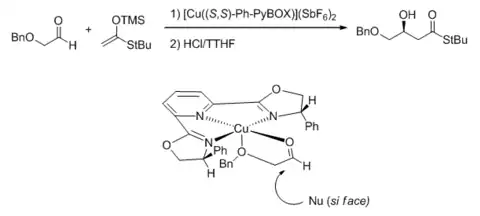
Metal complexes incorporating bis(oxazoline) ligands are effective for a wide range of asymmetric catalytic transformations and have been the subject of numerous literature reviews.[10][11][12] The neutral character of bis(oxazoline)s makes them well suited to use with noble metals, with copper complexes being particularly common.[11] Their most important and commonly used applications are in carbon–carbon bond forming reactions.
Carbon–carbon bond forming reactions
bis(oxazoline) ligands have been found to be effective for a range of asymmetric cycloaddition reactions, this began with the very first application of BOX ligands in carbenoid cyclopropanations[13] and has been expanded to include 1,3-Dipolar cycloaddition and Diels-Alder reactions. Bisoxazoline ligands have also been found to be effective for aldol, Michael and ene reactions, amongst many others
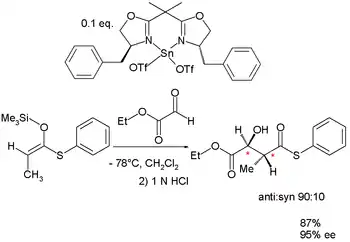 Evans 1997:[14] BOX assisted Aldol reaction |
 Aggarwal 1998:[15] BOX assisted Diels-Alder reaction resulting in verbenone synthesis. The final conversion with diphenylphosphoryl azide involves a modified Curtius rearrangement |
Other reactions
The success of bis(oxazoline) ligands for carbenoid cyclopropanations led to their application for aziridination. Another common reaction is hydrosilylation, which dates back to the first use of PyBOX ligands.[16] Other niche applications include as fluorination catalysts[17] and for Wacker-type cyclisations.[18]
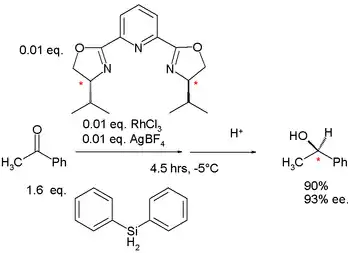 Nishiyama 1989:[16] Enantioselective hydrosilylation |
History

Oxazoline ligands were first used for asymmetric catalysis in 1984 when Brunner et al. showed a single example, along with a number of Schiff bases, as being effective for enantioselective carbenoid cyclopropanation.[19] Schiff bases were prominent ligands at the time, having been used by Ryōji Noyori during the discovery of asymmetric catalysis in 1968[20] (for which he and William S. Knowles would later be awarded the Nobel Prize in Chemistry). Brunner's work was influenced by that of Tadatoshi Aratani, who had worked with Noyori,[21] before publishing a number of papers on enantioselective cyclopropanation using Schiff bases.[22][23][24]
In this first usage the oxazoline ligand performed poorly, giving an ee of 4.9% compared to 65.6% from one of the Schiff base ligands. However Brunner reinvestigated oxazoline ligands during research into the monophenylation of diols, leading to the development of chiral pyridine oxazoline ligands, which achieved ee's of 30.2% in 1986[25] and 45% in 1989.[26] In the same year Andreas Pfaltz et al. reported the use of C2‑symmetric semicorrin ligands for enantioselective carbenoid cyclopropanations, achieving impressive results with ee's of between 92-97%.[27] Reference was made to both Brunner's and Aratani's work, however the design of the ligands was also largely based on his earlier work with various macrocycles.[28] A disadvantage of these ligands however, was that they required a multi-step synthesis with a low overall yield of approximately 30%.
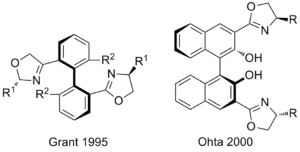
Brunner's work led to the development of very first bisoxazolines by Nishiyama et al., who synthesised the first PyBox ligands in 1989. These ligands were used in the hydrosilylation of ketones; achieving ee's of up to 93%[16] The first BOX ligands were reported a year later by Masamune et al.[13] and were first used in copper catalysed carbenoid cyclopropanation reactions; achieving ee's of up to 99% with 1% molar loadings. This was a remarkable result for the time and generated significant interest in the BOX motif. As the synthesis of 2-oxazoline rings was already well established at this time (literature reviews in 1949[29] and 1971[30]), research proceeded quickly, with papers from new groups being published within a year.[31][32] and review articles being published by 1996.[33] Today a considerable number of bis(oxazoline) ligands exist; structurally these are still largely based around the classic BOX and PyBOX motifs, however they also include a number of alternative structures, such as axially chiral compounds.[34][35]
References
- Evans, David A.; Miller, Scott J.; Lectka, Thomas; von Matt, Peter (1 August 1999). "Chiral Bis(oxazoline)copper(II) Complexes as Lewis Acid Catalysts for the Enantioselective Diels−Alder Reaction". Journal of the American Chemical Society. 121 (33): 7559–7573. doi:10.1021/ja991190k.
- Thorhauge, Jacob; Roberson, Mark; Hazell, Rita G.; Jørgensen, Karl Anker (15 April 2002). "On the Intermediates in Chiral Bis(oxazoline)copper(II)-Catalyzed Enantioselective Reactions—Experimental and Theoretical Investigations". Chemistry: A European Journal. 8 (8): 1888. doi:10.1002/1521-3765(20020415)8:8<1888::AID-CHEM1888>3.0.CO;2-9.
- Evans, David A.; Burgey, Christopher S.; Kozlowski, Marisa C.; Tregay, Steven W. (1 February 1999). "Symmetric Copper(II) Complexes as Chiral Lewis Acids. Scope and Mechanism of the Catalytic Enantioselective Aldol Additions of Enolsilanes to Pyruvate Esters". Journal of the American Chemical Society. 121 (4): 686–699. doi:10.1021/ja982983u.
- Marigo, Mauro; Kjærsgaard, Anne; Juhl, Karsten; Gathergood, Nicholas; Jørgensen, Karl Anker (23 May 2003). "Direct Catalytic Asymmetric Mannich Reactions of Malonates and -Keto Esters". Chemistry: A European Journal. 9 (10): 2359–2367. doi:10.1002/chem.200204679. PMID 12772311.
- Evans, David A.; Burgey, Christopher S.; Paras, Nick A.; Vojkovsky, Tomas; Tregay, Steven W. (1 June 1998). "C2-Symmetric Copper(II) Complexes as Chiral Lewis Acids. Enantioselective Catalysis of the Glyoxylate−Ene Reaction". Journal of the American Chemical Society. 120 (23): 5824–5825. doi:10.1021/ja980549m.
- Evans, David A.; Willis, Michael C.; Johnston, Jeffrey N. (1 September 1999). "Catalytic Enantioselective Michael Additions to Unsaturated Ester Derivatives Using Chiral Copper(II) Lewis Acid Complexes". Organic Letters. 1 (6): 865–868. doi:10.1021/ol9901570. PMID 10823215.
- Aggarwal, Varinder K.; Belfield, Andrew J. (1 December 2003). "Catalytic Asymmetric Nazarov Reactions Promoted by Chiral Lewis Acid Complexes". Organic Letters. 5 (26): 5075–5078. doi:10.1021/ol036133h. PMID 14682768.
- Yao, Sulan; Johannsen, Mogens; Audrain, Hélène; Hazell, Rita G.; Jørgensen, Karl Anker (1 September 1998). "Catalytic Asymmetric Hetero-Diels−Alder Reactions of Ketones: Chemzymatic Reactions". Journal of the American Chemical Society. 120 (34): 8599–8605. doi:10.1021/ja981710w.
- Evans, David A.; Kozlowski, Marisa C.; Murry, Jerry A.; Burgey, Christopher S.; Campos, Kevin R.; Connell, Brian T.; Staples, Richard J. (1 February 1999). "C2-Symmetric Copper(II) Complexes as Chiral Lewis Acids. Scope and Mechanism of Catalytic Enantioselective Aldol Additions of Enolsilanes to (Benzyloxy)acetaldehyde". Journal of the American Chemical Society. 121 (4): 669–685. doi:10.1021/ja9829822.
- Ghosh, Arun K.; Mathivanan, Packiarajan; Cappiello, John (1998). "C2-Symmetric chiral bis(oxazoline)–metal complexes in catalytic asymmetric synthesis". Tetrahedron: Asymmetry. 9 (1): 1–45. doi:10.1016/S0957-4166(97)00593-4. PMC 6234853. PMID 30457575.
- Johnson, Jeffrey S.; Evans, David A. (1 June 2000). "Chiral Bis(oxazoline) Copper(II) Complexes: Versatile Catalysts for Enantioselective Cycloaddition, Aldol, Michael, and Carbonyl Ene Reactions". Accounts of Chemical Research. 33 (6): 325–335. doi:10.1021/ar960062n. PMID 10891050.
- Desimoni, Giovanni; Faita, Giuseppe; Jørgensen, Karl Anker (9 November 2011). "Update 1 of: C2-Symmetric Chiral Bis(oxazoline) Ligands in Asymmetric Catalysis". Chemical Reviews. 111 (11): PR284–PR437. doi:10.1021/cr100339a. PMID 22077602.
- Lowenthal, Richard E; Abiko, Atsushi; Masamune, Satoru (1990). "Asymmetric catalytic cyclopropanation of olefins: bis-oxazoline copper complexes". Tetrahedron Letters. 31 (42): 6005–6008. doi:10.1016/S0040-4039(00)98014-6.
- Evans, David A.; MacMillan, David W. C.; Campos, Kevin R. (1 November 1997). "-Symmetric Tin(II) Complexes as Chiral Lewis Acids. Catalytic Enantioselective Anti Aldol Additions of Enolsilanes to Glyoxylate and Pyruvate Esters". Journal of the American Chemical Society. 119 (44): 10859–10860. doi:10.1021/ja972547s.
- Aggarwal, Varinder K.; Anderson, Emma S.; Elfyn Jones, D.; Obierey, Kerstin B.; Giles, Robert (1 January 1998). "Catalytic asymmetric Diels–Alder reactions of α-thioacrylates for the preparation of norbornenone". Chemical Communications (18): 1985–1986. doi:10.1039/a805366i.
- Nishiyama, Hisao.; Sakaguchi, Hisao.; Nakamura, Takashi.; Horihata, Mihoko.; Kondo, Manabu.; Itoh, Kenji. (1 March 1989). "Chiral and C2-symmetrical bis(oxazolinylpyridine)rhodium(III) complexes: effective catalysts for asymmetric hydrosilylation of ketones". Organometallics. 8 (3): 846–848. doi:10.1021/om00105a047.
- Ma, Jun-An; Cahard, Dominique (2004). "Copper(II) triflate-bis(oxazoline)-catalysed enantioselective electrophilic fluorination of β-ketoesters". Tetrahedron: Asymmetry. 15 (6): 1007–1011. doi:10.1016/j.tetasy.2004.01.014.
- Uozumi, Yasuhiro; Kyota, Hirokazu; Kato, Kazuhiko; Ogasawara, Masamichi; Hayashi, Tamio (1 March 1999). "Design and Preparation of 3,3'-Disubstituted 2,2'-Bis(oxazolyl)-1,1'-binaphthyls (boxax): New Chiral Bis(oxazoline) Ligands for Catalytic Asymmetric Wacker-Type Cyclization". The Journal of Organic Chemistry. 64 (5): 1620–1625. doi:10.1021/jo982104m. PMID 11674227.
- Brunner, Henri; Miehling, Wolfgang (1 October 1984). "Enantioselektive Cyclopropanierung von 1,1-Diphenylethylen und Diazoessigester mit Kupfer-Katalysatoren". Monatshefte für Chemie - Chemical Monthly. 115 (10): 1237–1254. doi:10.1007/BF00809355.
- Nozaki, H.; Takaya, H.; Moriuti, S.; Noyori, R. (1968). "Homogeneous catalysis in the decomposition of diazo compounds by copper chelates". Tetrahedron. 24 (9): 3655–3669. doi:10.1016/S0040-4020(01)91998-2.
- Nozaki, H.; Aratani, T.; Toraya, T.; Noyori, R. (1971). "Asymmetric syntheses by means of (−)-sparteine modified organometallic reagents". Tetrahedron. 27 (5): 905–913. doi:10.1016/S0040-4020(01)92490-1.
- Aratani, T.; Yoneyoshi, Y.; Nagase, T. (1975). "Asymmetric synthesis of chrysanthemic acid. An application of copper carbenoid reaction". Tetrahedron Letters. 16 (21): 1707–1710. doi:10.1016/S0040-4039(00)72239-8.
- Aratani, T.; Yoneyoshi, Y.; Nagase, T. (1977). "Asymmetric synthesis of chrysanthemic acid. An application of copper carbenoid reaction". Tetrahedron Letters. 18 (30): 2599–2602. doi:10.1016/S0040-4039(01)83830-2.
- Aratani, Tadatoshi; Yoneyoshi, Yukio; Nagase, Tsuneyuki (1982). "Asymmetric synthesis of permethric acid. stereochemistry of chiral copper carbenoid reaction". Tetrahedron Letters. 23 (6): 685–688. doi:10.1016/S0040-4039(00)86922-1.
- Brunner, Henri; Obermann, Uwe; Wimmer, Peter (1 November 1986). "Asymmetrische katalysen". Journal of Organometallic Chemistry. 316 (1–2): C1–C3. doi:10.1016/0022-328X(86)82093-9.
- Brunner, Henri.; Obermann, Uwe.; Wimmer, Peter. (1 March 1989). "Asymmetric catalysis. 44. Enantioselective monophenylation of diols with cupric acetate/pyridinyloxazoline catalysts". Organometallics. 8 (3): 821–826. doi:10.1021/om00105a039.
- Fritschi, Hugo; Leutenegger, Urs; Pfaltz, Andreas (1 November 1986). "Chiral Copper-Semicorrin Complexes as Enantioselective Catalysts for the Cyclopropanation of Olefins by Diazo Compounds". Angewandte Chemie International Edition in English. 25 (11): 1005–1006. doi:10.1002/anie.198610051.
- Pfaltz, Andreas (1999). "From Corrin Chemistry to Asymmetric Catalysis - A Personal Account". Synlett. 1999 (S1): 835–842. doi:10.1055/s-1999-3122.
- Wiley, Richard H.; Bennett, Leonard L. (1949). "The Chemistry of the Oxazolines". Chemical Reviews. 44 (3): 447–476. doi:10.1021/cr60139a002.
- Frump, John A. (1971). "Oxazolines. Their preparation, reactions, and applications". Chemical Reviews. 71 (5): 483–505. doi:10.1021/cr60273a003.
- Evans, David A.; Woerpel, Keith A.; Hinman, Mira M.; Faul, Margaret M. (1 January 1991). "Bis(oxazolines) as chiral ligands in metal-catalyzed asymmetric reactions. Catalytic, asymmetric cyclopropanation of olefins". Journal of the American Chemical Society. 113 (2): 726–728. doi:10.1021/ja00002a080.
- Corey, E. J.; Imai, Nobuyuki; Zhang, Hong Yue (1 January 1991). "Designed catalyst for enantioselective Diels-Alder addition from a C2-symmetric chiral bis(oxazoline)-iron(III) complex". Journal of the American Chemical Society. 113 (2): 728–729. doi:10.1021/ja00002a081.
- Pfaltz, Andreas; Adolfsson, Hans; Wärnmark, Kenneth; Aasbø, Kari; Klinga, Martti; Romerosa, Antonio (1 January 1996). "Design of Chiral Ligands for Asymmetric Catalysis: from C2-Symmetric Semicorrins and Bisoxazolines to Non-Symmetric Phosphinooxazolines" (PDF). Acta Chemica Scandinavica. 50: 189–194. doi:10.3891/acta.chem.scand.50-0189.
- Gant, Thomas G.; Noe, Mark C.; Corey, E.J. (1 November 1995). "The first enantioselective synthesis of the chemotactic factor sirenin by an intramolecular [2 + 1] cyclization using a new chiral catalyst". Tetrahedron Letters. 36 (48): 8745–8748. doi:10.1016/0040-4039(95)01924-7.
- Ohta, Tetsuo; Ito, Junji; Hori, Kazushige; Kodama, Hidehiko; Furukawa, Isao (2000). "Lanthanide-catalyzed asymmetric 1,3-dipolar cycloaddition of nitrones to alkenes using 3,3′-bis(2-oxazolyl)-1,1′-bi-2-naphthol (BINOL-Box) ligands". Journal of Organometallic Chemistry. 603 (1): 6–12. doi:10.1016/S0022-328X(00)00024-3.